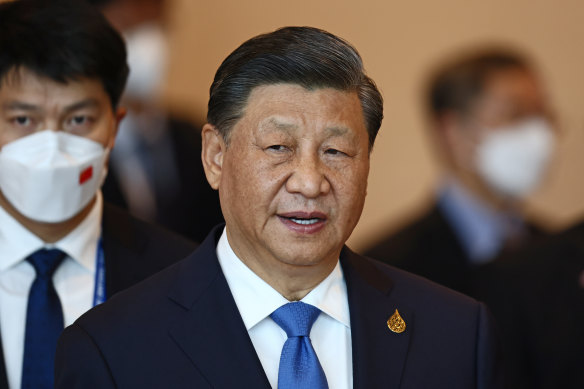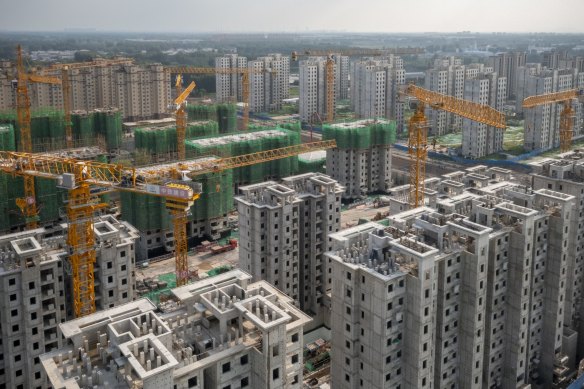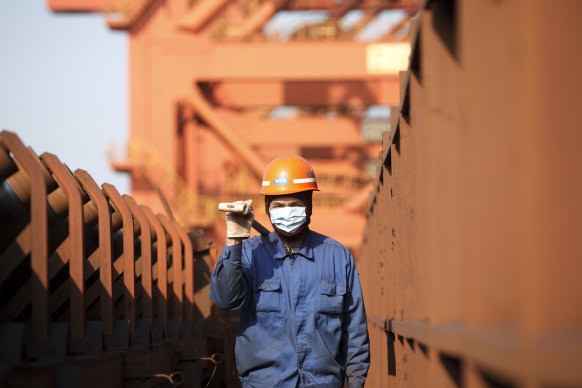Australia is desperate for China to wake up from its property nightmare
China’s key housing market appears to have stabilised after 16 consecutive months of decline and heavy intervention by the central government. Whether that’s sufficient to reignite growth at the levels China is more accustomed to is another question.
Last week’s housing data showed that prices for new homes were stable in January for the first time since August 2021. Price for homes on the secondary market slipped another 0.28 per cent, but the rate of decline has slowed from December’s 0.41 per cent. Big developers’ sales remain depressed, around a third lower than in January last year.

Housing, and the property-related activity more broadly, are key drivers of China’s economy, accounting for about 30 per cent of its GDP, and therefore some degree of rebound from its depressed levels is critical to its overall growth rate.
Beijing has thrown a lot at trying to stimulate the sector, which has been roiled by the continuing defaults on their debt and the liquidity crisis big developers are experiencing. There is a massive inventory of unsold and uncompleted projects to be moved but there is distrust among prospective buyers, who have seen existing buyers of pre-sold apartments left with mortgages but no properties.
Last November, just before Xi Jinping abandoned the “COVID zero” policies that resulted in extraordinarily severe rolling lockdowns of China’s major cities, Beijing rolled back another of his signature policies, the “three red lines” limits on property developers’ leverage that caused the sector to implode.
It also caused the country’s major banks to announce massive funding support for developers to try to ease their liquidity crisis as part of a 16-point rescue plan for the sector.
The plan included local government support for lower deposits on housing, lower interest rates for new borrowers, government support for developers’ bond sales, loans from government banks to complete projects, funding support for purchases of projects by the stronger developers from the weaker ones and the restructuring of loan contracts for borrowers made unemployed by COVID.
Overall, it represented a massive U-turn from the key policies that were in place until Xi’s hand was forced by the impact of his deleveraging policies and the effects of the COVID zero approach.
He also ended a crackdown on China’s big technology companies that had chilled their activity.
While the January data offers some limited encouragement – at least the downward spiral in the property sector appears to have ended – there is a query over whether the raft of supportive policies will be able to engineer a material turnaround in the sector.
There is a huge over-hang of uncompleted or unsold property inventory to be worked through, along with buyers who’ve seen their peers burned by the pre-sales model that was ubiquitous in the sector.

Indebted local governments, which rely on income from property sales for between a third and a half of their income, will become even more leveraged than they already are if they are to play their role in the effort to stimulate activity.
With China’s population now starting to shrink and near-20 per cent unemployment among younger Chinese, there is also a longer term questionmark over a reliance on property as a major driver of economic growth.
After China reported 3 per cent growth in its economy last year (a number that has been met with some cynicism given the apparent panic the performance of the economy induced in Beijing) it resorted to a well-thumbed playbook, with announcements of significant support, not just form property, but infrastructure more broadly.
How China emerges from the pandemic years is important, not just for China and both its domestic and geopolitical capabilities and ambitions, but for the global economy.
After the 2008 global financial crisis China embarked on a $US600 billion ($874 billion) infrastructure investment spending-spree that underwrote and turbocharged its growth rate (and helped the global economy recover) until the outbreak of the pandemic. In the decade before COVID, it averaged GDP growth of almost 8 per cent a year.
Confronted with an economy ravaged by its rigid and harsh response to the pandemic, Xi has resorted to those familiar policies even though China is now carrying a far larger debt burden. JP Morgan has estimated China’s debt-to-GDP ratio at 285 per cent and forecast that it will add another 10 percentage points to that ratio this year).
The centrally-directed investment in industrial activity and infrastructure may also be even less productive than its response to the financial crisis, when “ghost” cities were built and there was infrastructure investment that could only be justified because local governments had been directed to borrow and invest in infrastructure.
That experience suggests there could be a lot more unproductive spending and some crowding out of the more productive private sector.
The International Monetary Fund has forecast GDP growth of 5.2 per cent this year on the back of the stimulus and an expectation that China’s consumers will drive growth in consumption now that they’be had the shackles of the COVID zero policies removed.
There an obvious “base” effect – the comparison this year will be with the COVID-depressed growth of 2022 – which will have worked its way through the numbers by the end of this year, making sustenance of the mid-single digit growth rates China’s leadership targets more challenging from 2024.
At this point it is too early in the year to gauge whether consumers have returned although there has been an understandable pickup in activity relative to the recessed COVID years.
During the Lunar New Year period travel and tourism rebounded strongly, with passenger traffic up 76 per cent, albeit still nearly half that of the pre-COVID era. Consumption was also almost 7 per cent higher than last year.

Whether those trends can be sustained is an open question. China’s households are savings-heavy but whether they’ll deploy them after the experience of the past three COVID-affected years will be critical to Xi’s ambition of permanently switching the composition of China’s growth away from exports (where prices for China’s goods are deflating as the global economy slows) and towards consumption.
How China emerges from the pandemic years is important, not just for China and both its domestic and geopolitical capabilities and ambitions, but for the global economy.
China has been the major driver of global growth since the 2008 financial crisis and will, if it can generate the growth the IMF believes is feasible, will be so again this year.
It’s also important for commodity-producing economies, like Australia’s, given that industrial and infrastructure investment drives demand for commodities like iron ore, copper and coal and would require increased imports of energy, with implications for already-elevated oil and gas prices.
There is, therefore, a lot at stake for Xi, the global economy (and Australia’s economy in particular) in the near term in China successfully managing the reopening of its economy.
How productive its stimulatory efforts are in the longer term will also have implications for the region and the rest of the world, although the range of external hopes for those outcomes might be somewhat more dispersed.
Most Viewed in Business
Source: Thanks smh.com